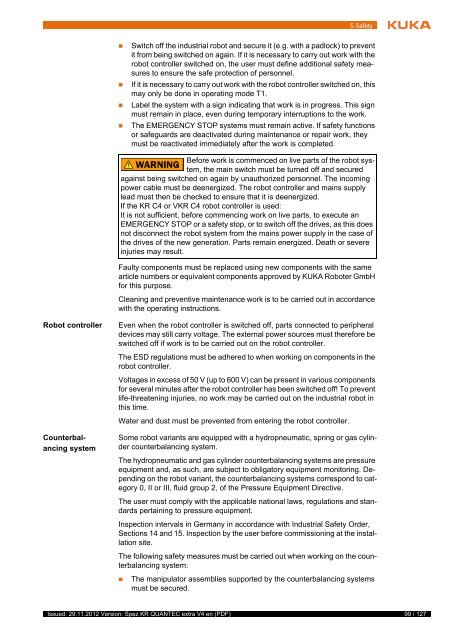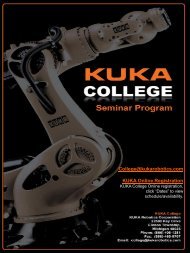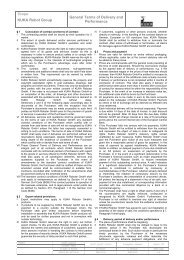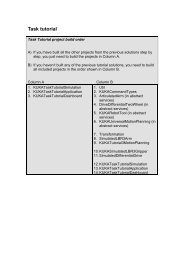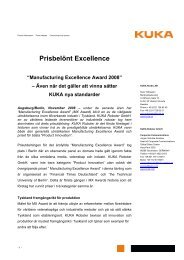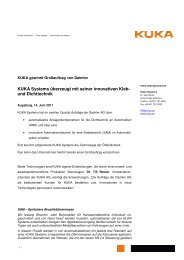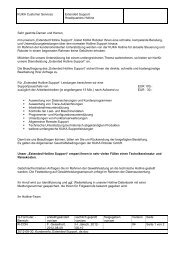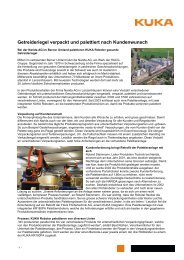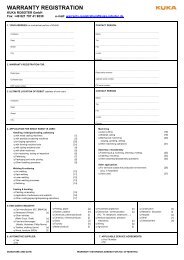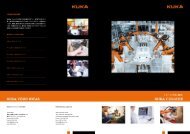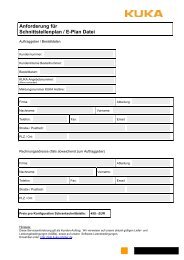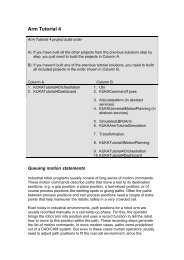KR QUANTEC extra - KUKA Robotics
KR QUANTEC extra - KUKA Robotics
KR QUANTEC extra - KUKA Robotics
Create successful ePaper yourself
Turn your PDF publications into a flip-book with our unique Google optimized e-Paper software.
Issued: 29.11.2012 Version: Spez <strong>KR</strong> <strong>QUANTEC</strong> <strong>extra</strong> V4 en (PDF)<br />
5 Safety<br />
Switch off the industrial robot and secure it (e.g. with a padlock) to prevent<br />
it from being switched on again. If it is necessary to carry out work with the<br />
robot controller switched on, the user must define additional safety measures<br />
to ensure the safe protection of personnel.<br />
If it is necessary to carry out work with the robot controller switched on, this<br />
may only be done in operating mode T1.<br />
Label the system with a sign indicating that work is in progress. This sign<br />
must remain in place, even during temporary interruptions to the work.<br />
The EMERGENCY STOP systems must remain active. If safety functions<br />
or safeguards are deactivated during maintenance or repair work, they<br />
must be reactivated immediately after the work is completed.<br />
Faulty components must be replaced using new components with the same<br />
article numbers or equivalent components approved by <strong>KUKA</strong> Roboter GmbH<br />
for this purpose.<br />
Cleaning and preventive maintenance work is to be carried out in accordance<br />
with the operating instructions.<br />
Robot controller Even when the robot controller is switched off, parts connected to peripheral<br />
devices may still carry voltage. The external power sources must therefore be<br />
switched off if work is to be carried out on the robot controller.<br />
The ESD regulations must be adhered to when working on components in the<br />
robot controller.<br />
Voltages in excess of 50 V (up to 600 V) can be present in various components<br />
for several minutes after the robot controller has been switched off! To prevent<br />
life-threatening injuries, no work may be carried out on the industrial robot in<br />
this time.<br />
Water and dust must be prevented from entering the robot controller.<br />
Counterbalancing<br />
system<br />
Before work is commenced on live parts of the robot system,<br />
the main switch must be turned off and secured<br />
against being switched on again by unauthorized personnel. The incoming<br />
power cable must be deenergized. The robot controller and mains supply<br />
lead must then be checked to ensure that it is deenergized.<br />
If the <strong>KR</strong> C4 or V<strong>KR</strong> C4 robot controller is used:<br />
It is not sufficient, before commencing work on live parts, to execute an<br />
EMERGENCY STOP or a safety stop, or to switch off the drives, as this does<br />
not disconnect the robot system from the mains power supply in the case of<br />
the drives of the new generation. Parts remain energized. Death or severe<br />
injuries may result.<br />
Some robot variants are equipped with a hydropneumatic, spring or gas cylinder<br />
counterbalancing system.<br />
The hydropneumatic and gas cylinder counterbalancing systems are pressure<br />
equipment and, as such, are subject to obligatory equipment monitoring. Depending<br />
on the robot variant, the counterbalancing systems correspond to category<br />
0, II or III, fluid group 2, of the Pressure Equipment Directive.<br />
The user must comply with the applicable national laws, regulations and standards<br />
pertaining to pressure equipment.<br />
Inspection intervals in Germany in accordance with Industrial Safety Order,<br />
Sections 14 and 15. Inspection by the user before commissioning at the installation<br />
site.<br />
The following safety measures must be carried out when working on the counterbalancing<br />
system:<br />
The manipulator assemblies supported by the counterbalancing systems<br />
must be secured.<br />
99 / 127


